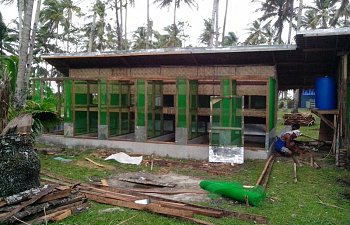Here are my new breeding coops that are just being finished at our CocoBeach Farm
Being in the Philippines, we dont need to worry about cold and snow, but we have our own issues.
Prior to construction of these coops, I had built 2 coops 8x8 and 5 coops 6x6. I needed 6 breeding coops for small numbers of birds - up to 6 birds total.
All my coops have an area under the coop that is closed in as well as a protected run totalling 250% of the coop area.
In designing coops. my goals are:
Secondary challenges are predators. Feral dogs, cats and rats. Dogs are very rare. Cats are the same but have killed several chicks. Rats have become almost insignificant with a major abatement program we initiated.
So this is what we came up with......

A foundation was made of cinder blocks with a total pen size of 4x10. this continues with the same scale of coop to pen size as our other coops. The Cinder blocks act to protect the coconut lumber from the soil as well as prevent dogs tunneling.

On top of that we created the base for the coops.We used true 2x3 lumber and 1/2" plywood for the floor of each 4x4 coop. We place 18" of flat GI sheet along the base to prevent rats from climbing up the coop.

The thatch roof is very light so it uses just a few 2x3s and bamboo strips to supplort it. Green nylon mesh is used in place of hardware cloth.


The walls of the coop are 1/4 marine plywood with a woven bamboo material called amacan over the top for decorative and protective appeal. Its incredibly cheap in the markets at around $3 for a 6x6 sheet


Egg boxes span 2 coops with a 1up 1 down in each coop. The human doors are at the rear for ease of cleaning.


The roof was made to attach to the neighboring 6x6 coops so as to provide a wind break to the leeward side of the coops so we can grow a few fruit trees that dont like salt wind.
All lumber is coconut from spent trees on our farm. The cinder blocks for the foundation, thatch roof and the amacan are made locally.
Each set of coops we build adapt from our original as we learn what we should or could have done better.
Just about finished. The pen doors need to be hung, rice husks for bedding, 3" bamboo roosts and a fish net pen ceiling and we are all done but the clean up.
Being in the Philippines, we dont need to worry about cold and snow, but we have our own issues.
Prior to construction of these coops, I had built 2 coops 8x8 and 5 coops 6x6. I needed 6 breeding coops for small numbers of birds - up to 6 birds total.
All my coops have an area under the coop that is closed in as well as a protected run totalling 250% of the coop area.
In designing coops. my goals are:
- Use as much material from renewable or recycled products as possible.
- Make the coops fit in with the environement as much as possible.
- Provide adequate ventilation and envitonmental protection as possible.
Secondary challenges are predators. Feral dogs, cats and rats. Dogs are very rare. Cats are the same but have killed several chicks. Rats have become almost insignificant with a major abatement program we initiated.
So this is what we came up with......
A foundation was made of cinder blocks with a total pen size of 4x10. this continues with the same scale of coop to pen size as our other coops. The Cinder blocks act to protect the coconut lumber from the soil as well as prevent dogs tunneling.
On top of that we created the base for the coops.We used true 2x3 lumber and 1/2" plywood for the floor of each 4x4 coop. We place 18" of flat GI sheet along the base to prevent rats from climbing up the coop.
The thatch roof is very light so it uses just a few 2x3s and bamboo strips to supplort it. Green nylon mesh is used in place of hardware cloth.
The walls of the coop are 1/4 marine plywood with a woven bamboo material called amacan over the top for decorative and protective appeal. Its incredibly cheap in the markets at around $3 for a 6x6 sheet
Egg boxes span 2 coops with a 1up 1 down in each coop. The human doors are at the rear for ease of cleaning.
The roof was made to attach to the neighboring 6x6 coops so as to provide a wind break to the leeward side of the coops so we can grow a few fruit trees that dont like salt wind.
All lumber is coconut from spent trees on our farm. The cinder blocks for the foundation, thatch roof and the amacan are made locally.
Each set of coops we build adapt from our original as we learn what we should or could have done better.
Just about finished. The pen doors need to be hung, rice husks for bedding, 3" bamboo roosts and a fish net pen ceiling and we are all done but the clean up.


 ). I haven't had a chance yet to go back and research where else you've posted - saw other pics completely in the Inventions thread.
). I haven't had a chance yet to go back and research where else you've posted - saw other pics completely in the Inventions thread.

